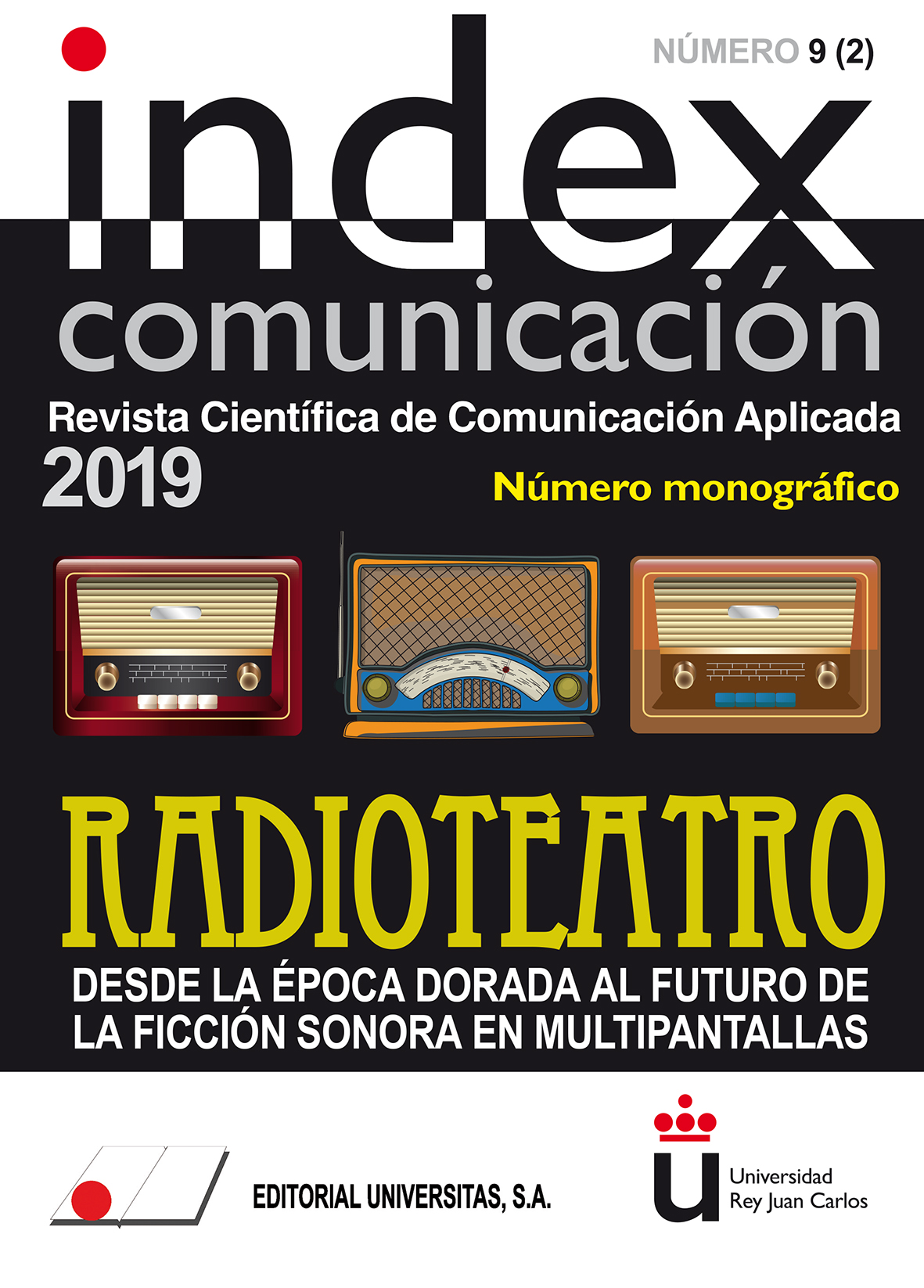The Role of Narrator in Serial Radio Fiction: The Case of ‘Taxi Key’
DOI:
https://doi.org/10.33732/ixc/09/02LafiguKeywords:
Series, Taxi Key, Radio Script, Detective Fiction Genre, Storyteller, Autodiegetic,Abstract
In spite of the prominence acquired by dialogues among characters in creating a series, we cannot ignore that radio speech can be represented in turn by the narrators's presence. For this reason, in the present article the emblematic Taxi Key detective series has been selected as an object of study, in order to determine the narrators's appearance percentage in the series episodes, the narrator's typology that prevails and the main functions that plays in this fictional product. It is an exploratory study in which descriptive and inferential analyzes have been made from Taxi Key original radio scripts. The results of the study reveal that narrator's presence reaches the most significant prevalence in the episodes of the sample, being the autodiegetic narrator who stands as the most frequent type of narrator. Providing contextual information, acting as a nexus and transition device between scenes and assessing the characters or incorporating them on stage are the narrator's functions that prevail in this series that remained almost twenty years on Radio Barcelona network.Metrics
References
AGUILERA, M. y ARQUERO BLANCO, I. (2017). La ficción sonora y la realización en directo: el reto de RNE. Área Abierta. Revista de comunicación audiovisual y publicitaria, 17(1), 117-146. Recuperado el 1 de febrero de 2019, desde: https://revistas.ucm.es/index.php/ARAB/article/view/54404
ARNHEIM, R. (1980). Estética radiofónica. Barcelona: Gustavo Gili.
BALSEBRE, A. (2007). El lenguaje radiofónico. Madrid: Cátedra.
BALSEBRE, A. (2002). Historia de la radio en España. Vol. II (1939-1985). Madrid: Cátedra.
BAREA, P. (1994). La estirpe de Sautier. La época dorada de la radionovela en España (1924-1964). Madrid: El País Aguilar.
BAREA, P. (2000). Teatro de los sonidos, sonidos del teatro: teatro-radio-teatro, ida y vuelta. Bilbao: Universidad del País Vasco. Servicio Editorial. Euskal Herriko Unibertsitatea. Argitarapen Zerbitzua.
CAMACHO, L. (1999). La imagen radiofónica. McGraw-Hill: México.
CASETTI, F. y DI CHIO, F. (1999): Análisis de la televisión. Instrumentos, métodos y prácticas de investigación. Barcelona: Paidós.
GARCÍA JIMÉNEZ, J. (1996). Narrativa audiovisual. Madrid: Cátedra.
GARCÍA LANDA, J. A. (1998). Acción, relato, discurso. Estructura de la ficción narrativa. Salamanca: Ediciones Universidad de Salamanca.
GARCÍA PEINADO, M. A. (1998). Hacia una teoría general de la novela. Madrid: Arco Libros.
GARCÍA, Mª. C. y BERGANZA Mª. R. (2005). El método científico aplicado a la investigación en Comunicación Mediática. En Mª. R.
BERGANZA y J. A. RUIZ SAN ROMÁN (Coord.): Investigar en Comunicación: guía práctica de métodos y técnicas de investigación social en Comunicación (pp. 19-42). Madrid: McGraw-Hill.
GUARINOS, V. (2009). Narrativa radiofónica. Madrid: Síntesis.
GENETTE, G. (1989). Figuras III. Barcelona: Lumen.
HERNÁNDEZ SAMPIERI, R.; FERNÁNDEZ COLLADO, C. y BAPTISTA LUCIO, P. (2010). Metodología de investigación. México: Mc Graw-Hill.
HURTADO, C. (2008). Montando Siritinga. Enlaces: revista del CES Felipe II, 9. Recuperado el 15 de febrero, 2019, desde:
http://www.cesfelipesegundo.com/revista/articulos2008b/ARTICUL
O_CARLOS_HURTADO_corregido.pdf
IGARTUA, J. J. (2006). Métodos cuantitativos de investigación en comunicación. Barcelona: Bosch Comunicación.
KAPLÚN, M. (1978). Producción de programas de radio. Quito: Ciespal.
MARTÍNEZ-COSTA, M. P. (1998). Tipología y funciones del narrador en los relatos radiofónicos. Comunicación y Cultura, 5/6, 97-104. Recuperado el 10 de febrero, 2019, desde:
file:///C:/Users/usuario/Downloads/Dialnet-TipologiaYFuncionesDelNarradorEnLosRelatosRadiofon-2901327%20(1).pdf
MAZA, M. y CERVANTES, C. (2000). Guión para medios audiovisuales: cine, radio y televisión. México: Pearson Educación.
ORTIZ SOBRINO, M. A. y VOLPINI, F. (2017). Realización, lenguaje y elecciones narrativas de radioteatro: tres aproximaciones a la creación de espacios sonoros en el tiempo. Área Abierta. Revista de comunicación audiovisual y publicitaria, 17(1), 13-36. Recuperado el 17 de febrero, 2019, desde: https://revistas.ucm.es/index.php/ARAB/article/view/53496
Radio Barcelona (1925-1958). Colección de guiones de la programación diaria de Radio Barcelona (1925-1958). [Manuscrito]. Barcelona: Universidad Autónoma de Barcelona. Biblioteca de Comunicación y Hemeroteca General.
Radio Barcelona (1950-1966). Colección de guiones de Taxi Key [Manuscrito]. Barcelona: Archivo de Radio Barcelona. Cadena SER.
RODERO, E. (2005). Producción Radiofónica. Madrid: Cátedra.
RODERO, E. y XOENGAS, X. (2010). Elaboración del relato en la ficción radiofónica. En E. RODERO y X. SOENGAS: Ficción radiofónica: cómo contar una historia en la radio (pp. 101-149). Madrid: Instituto RTVE.
Published
How to Cite
Issue
Section
License
Copyright (c) 2019 Elisa Arias García

This work is licensed under a Creative Commons Attribution-NonCommercial 4.0 International License.
Authors who submit to this journal agree to the following terms:
Authors retain copyright and ensure the magazine's right to be the first publication of the work as licensed under a Creative Commons Attribution-NoComercial 4.0 International License that allows others to share the work with an acknowledgment of authorship of the work and the initial publication in this magazine, with no commercial purpose.
Authors can establish separate additional agreements for non-exclusive distribution of the version of the work published in the magazine (for example, to an institutional repository or publish it in a book), with an acknowledgment of its initial publication in this journal.
It allows and authors are encouraged to disseminate their work electronically (eg, in institutional repositories or on their own website) prior to and during the submission process, as it can lead to productive exchanges, as well as a citation more early and most of the published work (See The Effect of Open Access).















